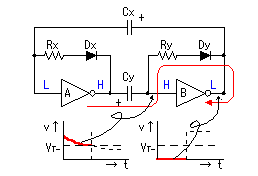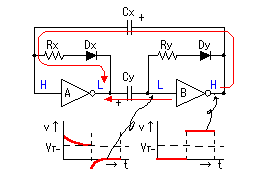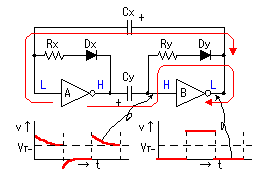Circuit explanation
for A-stable multivibrator (IC type)
First, it supposes that the input of the inverter A is the low level. At this time, the output of the inverter A becomes high level. If supposing that the electric charge isn't stored up in Cy, the electric current flows with the inverter A output At first, the condition of the inverter B is unsettled but because the output of the inverter B is not totally in the high level condition, above-mentioned electric current flows. When the electric charge begins to store up in Cy, Cy can be seen like the short circuit condition. So, the input of the inverter B becomes the high level condition. The output of the inverter B becomes the low level and above-mentioned electric current route is fully formed. However, because it is a small amount, most of the electric currents flow in the route which passes Ry. When the electric charge is stored up in Cy, the electric current decreases. Input voltage of the inverter B goes down with it and approaches the threshold voltage of the inverter B. Because the output of the inverter B is the low level (being 0V almost), the electric current alwayses fall through more through Ry, Dy and the input voltage of the inverter B becomes the threshold voltage (VT).  Then, the output of the inverter B reverses and becomes the high level condition. When the output of the inverter B becomes high level, the voltage of cathode side of Dy becomes high and the electric current which passes Ry stops. The output of the inverter B is conveyed to the input of the inverter B through Ry when there is not Dy. Then, it repeats the operation that the input of the inverter B becomes high level again and that the output becomes the low level and the inverter B has worked in the oscillation. The high level output of the inverter B makes the input of the inverter A the high level condition through Cx. At this time, the electric current flows with the inverter B output  In this, it returned to the first condition of the explanation. After that, it repeats this operation. There may be question here. First, it made the input of the inverter A the low level. When turning on, the condition of the inverter isn't decided. Each inverter characteristic isn't the same. The output of either the inverter becomes high level earlier and it fixes the condition. When there is an ideal inverter circuit, it is possible to think of repeat's not being worked, too. However, actually, there is not such one and it works repeatedly. Discharging by Cx, Cy After the inverter is turned, Cx or Cy must discharge. With this discharge, the electric current which pours off the inverter input becomes necessary. When it isn't possible to do this discharge, at the next period, because the electric charge starts from the stored condition, the input voltage of the invertor becomes the threshold voltage immediately. That is, the period of the repeat becomes short or the repeat isn't done. The period doesn't sometimes become long without discharge's being sufficiently done even if it makes the value of the capacitor big to make the repeat period long, too. When using 74HC04 as the inverter, because the input electric current flows hardly, the discharge isn't done and doesn't do the normal operation. Indeed, I attempted to work the circuit using 74HC04. At first, seemingly, it did the normal operation, but both LEDs lit up at the same time and didn't do the normal operation in case of being for a while. |